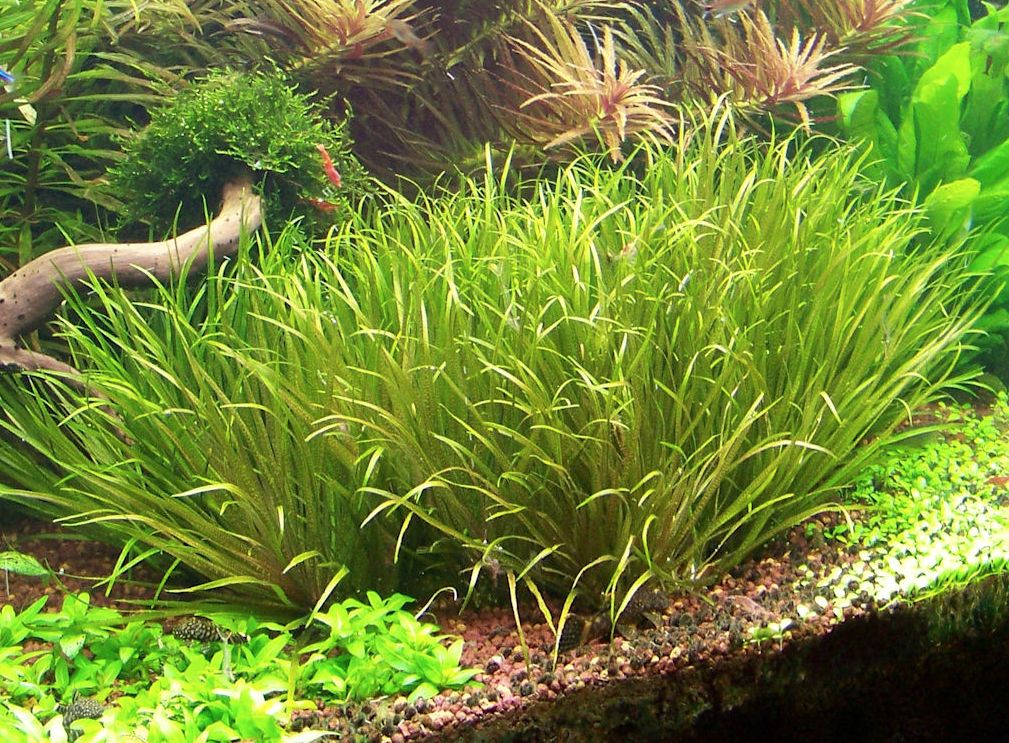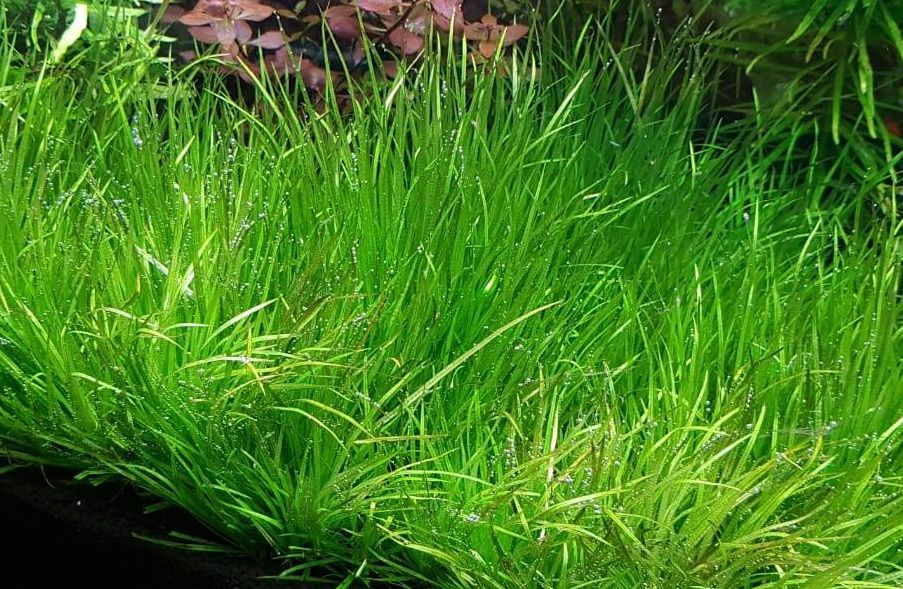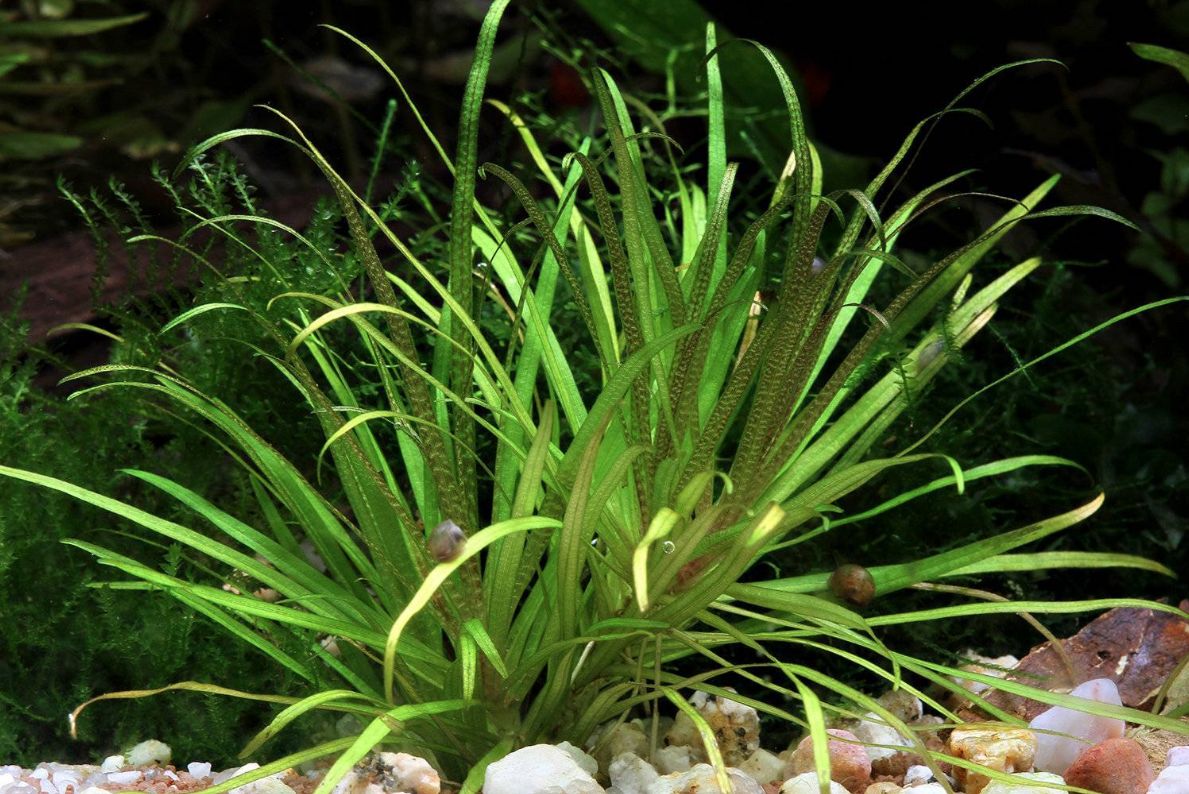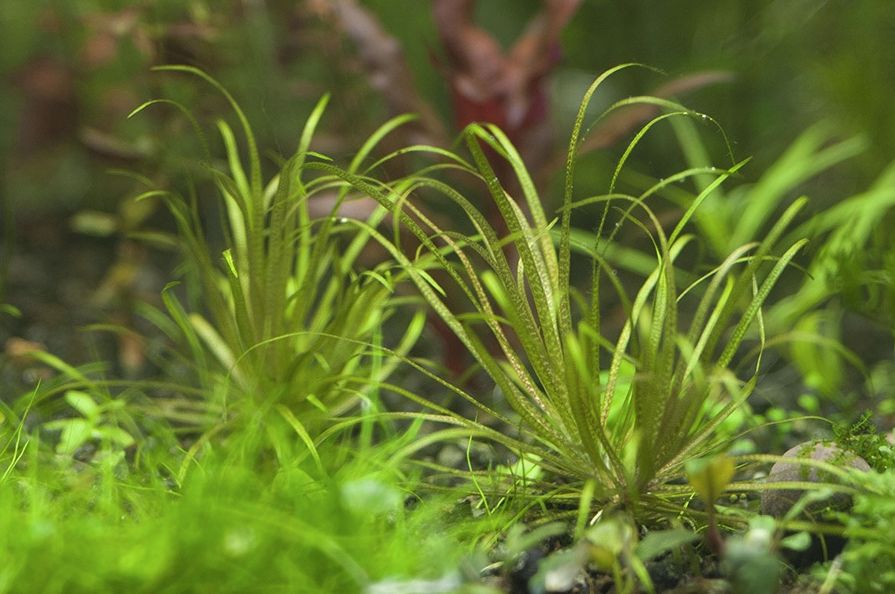Blyxa japonica is a favorite among aquascaping enthusiasts for its striking visual appeal and versatility. This plant stands out with its lush, vibrant rosette, creating an eye-catching focal point in any aquarium. Its stems, typically reaching around 10 cm in length, are adorned with light green leaves that spread in all directions, forming distinctive hillocks or mounds. These formations make Blyxa japonica ideal for use both as a centerpiece and as a complementary element along the edges of a composition, enhancing the overall depth and expansiveness of the aquascape.
In addition to its role as a focal point, Blyxa japonica can be cultivated to create a lush ‘carpet’ effect with its high stems. This versatility allows it to adapt to various design styles, from creating dense, textured backgrounds to adding intricate details to the aquarium floor.

Contents
Plant Habitat in the wild
Blyxa japonica, a striking aquatic plant, is renowned for its vibrant green stems and leaves. Native to South Asia, it is commonly found in Japan, China, and Taiwan. Since its introduction to aquarium enthusiasts in 1990, blyxa japonica has captivated aquascaping fans with its lush, rosette-like growth. Its popularity has fluctuated over the years, influenced by the arrival of new plant species that offer alternative options for the foreground of aquascapes.
This plant thrives in freshwater environments, such as ponds, slow-moving streams, marshes, and rice paddies. Blyxa japonica is well-adapted to both fully submerged and partially submerged conditions, growing in shallow waters ranging from just a few inches to a couple of feet deep. Its versatility and attractive appearance make it a favored choice for creating dynamic and visually appealing aquarium landscapes.

| Aspect | Blyxa japonica |
|---|---|
| Common Names | Dwarf blyxa, Blyxa |
| Family | Hydrocharitaceae |
| Leaf Shape | Slender, grass-like |
| Maximum Height | Up to 6 inches (15 cm) |
| Growth Rate | Moderate to fast |
| Light Requirements | Moderate to high |
| CO2 Requirement | Can benefit from CO2 |
| Water Temperature | 68-82°F (20-28°C) |
| pH Range | 6.0-7.5 |
| Hardiness | Moderately Hardy |
| Propagation | Lateral shoots |
| Ideal Placement | Midground to background |
| Suitable for Small Tanks | Yes |
| Ideal for Low-Tech Setups | No |
| Commonly Available | Yes |
Description
Blyxa japonica is a captivating stem plant known for its dense clusters of light green leaves and robust root system. It can grow up to 15 cm (6 inches) in both width and height, with leaves that reach up to 15 cm (6 inches) long and 3-4 mm wide. The plant blooms with delicate white flowers on thin stems. Its leaves can range in color from green to golden red, with more intense lighting bringing out a richer reddish hue.
Although blyxa japonica may resemble a fluffy bush of grass, it actually features a stem with closely spaced, slender leaves. The close proximity of the leaves and short internodes give it a bushy appearance.
Over time, the plant undergoes a change in appearance as its lower leaves begin to rot and the lower part of the stem becomes bare. The rosette, while still relatively compact (up to 15 cm high), can develop an increasingly bare base as the stem elongates.
To manage this, trim the stem just below the bottom leaves and remove the bare section, including the roots, from the substrate. Replant the remaining portion securely to prevent it from floating. With time, the plant will develop a new, thick root system. To support its growth, provide fertilizers that include organic nutrients.


Difficulties in keeping
Blyxa japonica is considered a plant of medium difficulty for aquarium enthusiasts (like Pogostemon Helferi). While it is not the easiest plant to care for, it is not the most challenging either. Its care requirements can be demanding, making it less suitable for beginners.
This plant can be quite sensitive to changes in its environment. Without proper conditions, blyxa japonica can struggle and may even die. To thrive, it requires stable water parameters, appropriate lighting, and regular maintenance. Ensuring these factors are consistently managed is crucial for the plant’s health.
For those new to aquarium keeping, it may be advisable to start with hardier plants before attempting blyxa japonica. For experienced aquarists, however, this plant can be a rewarding addition, offering vibrant color and texture to an aquascape.

Care and keeping in a tank
Blyxa japonica is moderately demanding aquatic plant which requires good illumination, CO2 supply and additional nutrition with fertilizes which promotes the best coloring of the plant. Only then the leaves get their maximum length and form a thick ‘brush of leaves’.
Even though plant requires tank conditions of medium difficulty, it grows quite fast and simple. Unlike other herbaceous plants used for middle and front stage, it doesn’t have long shoots. Instead of this it grows a lot of spurs which can be easily cut off from the parent plant with scissors.
Lighting
Provide blyxa japonica with moderate to high lighting to support its growth and vibrant coloration. LED lights or compact fluorescent lights are effective choices for this plant. Aim for around 8-12 hours of light per day to mimic natural conditions and promote healthy photosynthesis.
In well-lit tanks with adequate iron levels, blyxa japonica’s leaves will exhibit a striking golden-red hue. In lower light conditions, the plant will display a more subdued green color. To encourage blyxa japonica to bloom with small white flowers on long, thin stems, maintain high phosphate levels in the water.
Regularly monitor and adjust light intensity and nutrient levels to ensure the plant remains healthy and displays its best coloration. Proper care will help blyxa japonica thrive and enhance the beauty of your aquascape.
Water Parameters
Maintain a water temperature between 68-82°F (20-28°C) to ensure optimal growth conditions for blyxa japonica. This temperature range is suitable for most tropical aquariums.
Aim for a slightly acidic to neutral pH range of 6.0-7.5. Additionally, keep the water soft with a hardness level of 3-6 KH. Blyxa japonica tends to thrive better in softer water; hard water can hinder its growth and potentially lead to its decline. Regularly check and adjust these parameters to keep the plant healthy and vibrant.
Substrate
The feature of the plant is its requirements to the substrate – it should be rich with nutrients. Provide a nutrient-rich substrate to support the growth of Blyxa japonica. A nutrient substrate specifically designed for planted aquariums or a layer of nutrient-rich aquarium soil covered with a layer of gravel can be beneficial. Unless this requirement is met, even if the tank water has lots of microelements in it, still the plant will grow smaller and float up to the water surface.
It is not difficult to plant: you should put its shoots into the substrate where they will strike roots. The substrate should be about 3-5 cm thick. Young spurs require silty soil rich with nutrients, that’s why you should supply the plant with fertilizers.
CO2
Blyxa japonica thrives in both high-tech and low-tech aquarium setups. While supplemental CO2 injection can significantly boost growth rates and enhance the plant’s vibrant colors, it’s not a strict requirement for its success. In well-lit tanks, CO2 can promote more robust and faster growth, leading to a lush, dense appearance. However, Blyxa japonica is highly adaptable and can also flourish in low-tech aquariums without additional CO2. This flexibility makes it a versatile choice for various tank conditions, accommodating both beginners and experienced aquarists alike.
Nutrients
To ensure optimal growth of Blyxa japonica, consider dosing a comprehensive liquid fertilizer or using root tabs. These supplements provide essential nutrients such as nitrogen, phosphorus, and potassium, which are crucial for the plant’s health and development. Nitrogen supports vigorous leaf growth, phosphorus aids in root development, and potassium enhances overall plant vitality.
Propagation
Blyxa japonica can be propagated through lateral shoots, which can be a bit challenging at first due to their buoyancy in water. This high buoyancy can make it difficult to anchor them in the substrate. To successfully propagate this plant, carefully place the shoots in the substrate and gently press them down until they stay in place. Once the shoots establish roots, Blyxa japonica will rapidly develop a robust root system and produce new shoots, eventually forming a lush, bushy appearance.